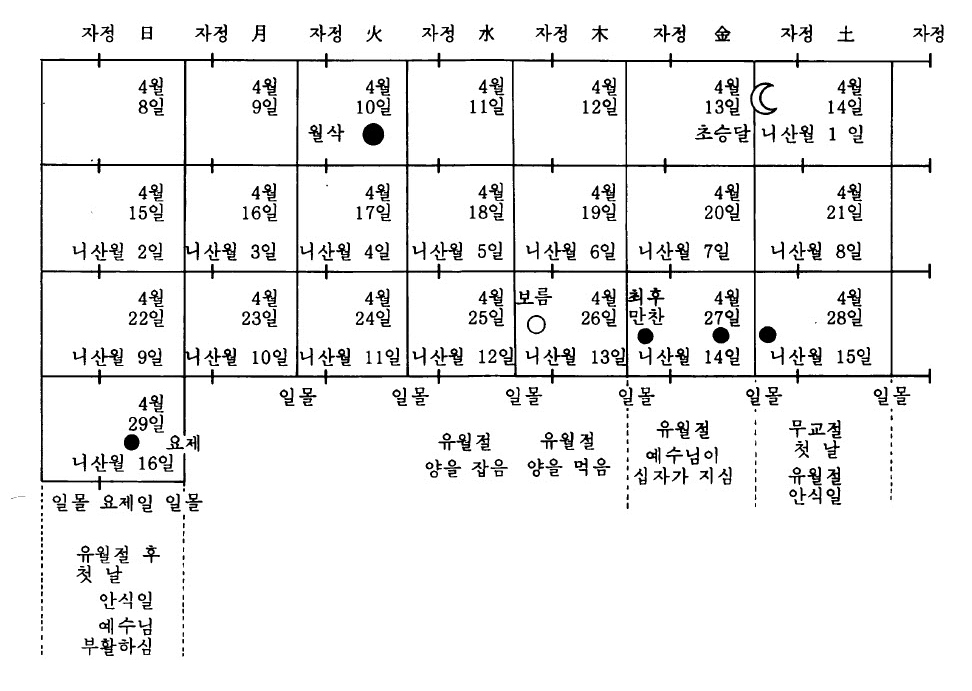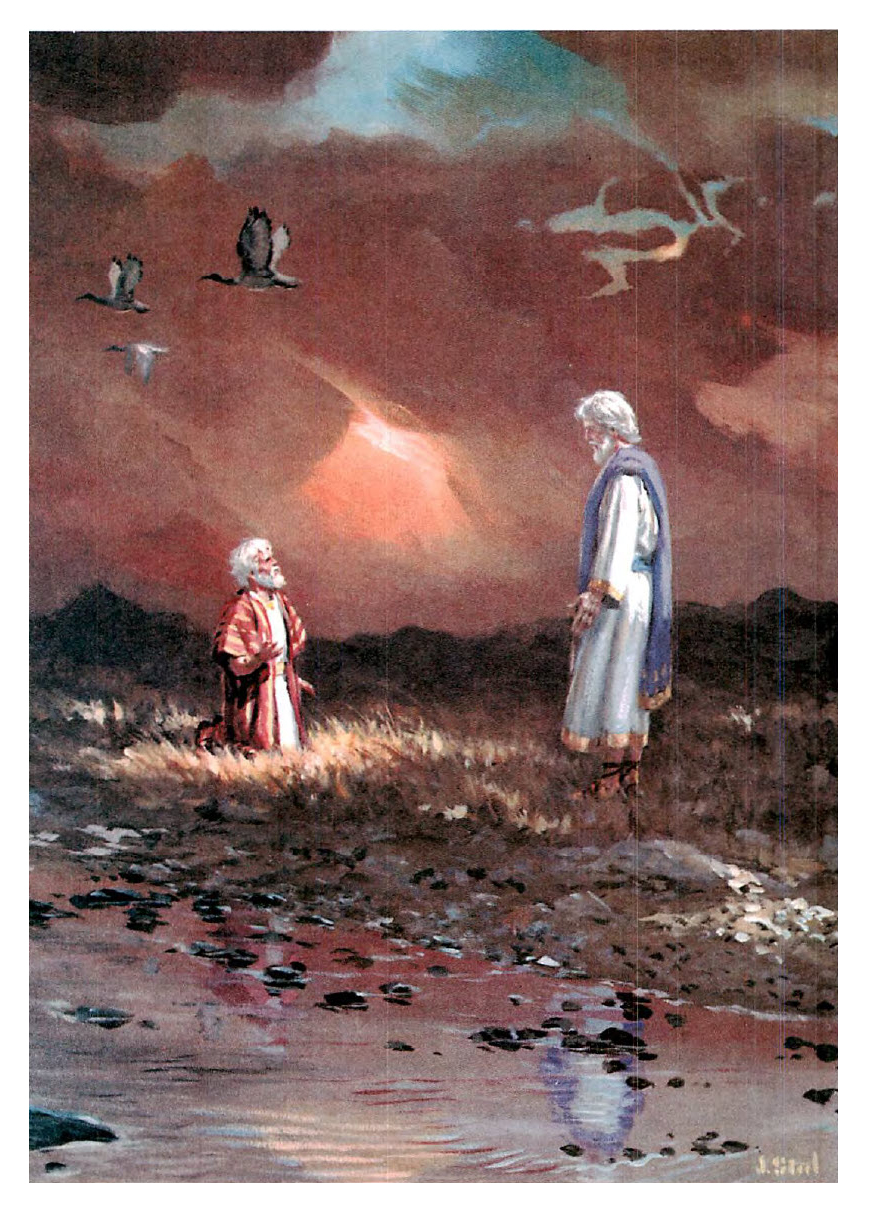천문학에 문외한인 사람들이 일식이나 월식을 정확히 예언하는 천문학자들의 재간에 경탄하는 것도 무리가 아니다. 그러나, 브라운 대학의 고대 천문학 전문가인 오 뉴즈바우어(O. Neugebauer) 교수에 의하면, 일식이나 월식을 정확히 알아내는 문제와 “〔매달 초승달이〕언제 처음으로 육안에 나타났느냐를 정확히 알아내는 것은 정반대의 경우이다. 현대의 모든 달 관측 일람표들은 고대의, 그것도 특정 지역들의 시계(視界) 상황들에 대해서는 자의적인 추측을 피할 수 없다. 그러한 추측들은 자의성이 대단히 높은 것들이다. 현대의 추측들이라 할지라도 대단히 불확실한 것이다. 초승달이 언제 육안으로 확인되었느냐 하는 문제는 일몰과 연관된 것이므로 그 같은 일람표들은 모두 하루 전체의 부정확성들을 포함하고 있다.”26 (254.5)
특별히 우리의 중심 주제와 관련해서 미국 해군 관측소(Naval Observatory)의 G. Μ. 클레멘스(Clemence)는 다음과 같이 말하였다. “월삭과 초승달 출현의 간격은 단순히 이론만 가지고는 계산해 낼 수 없다. 어떤 기준은 마땅히 개개 지역의 경험적 사실에 기초해서 마련되어야 할 것이다. 그리고, 개개의 관측이 실시되었던 시기의 현지 관습과 사정들에 의한 변차(變差)들도 고려되어야 한다∙∙∙ 기원후 1세기에 속해 있는 해(年)들의 니산월 14일의 연대들은 어떤 천문학적 서술로서 결정할 수 있는 것들이 아니다. 그 연대들은 그 당시 기록들에 대한 연구와 해석에 의해서만 결정될 수 있다.”27 (254.6)
따라서, 그리스도께서 수난당하신 해를 31년으로 잡지 말아야 할 이유는 전혀 없다. (254.7)
6. 기원후 31년 유월절 금요일 주장은 가능한 이야기인가?
앞에서 논의한 질의 문답 과정을 주의 깊게 살펴본 독자라면 기원후 31년 금요일 수난설에 대한 천문학자들의 이야기는 어떤 것인지 궁금해 할 것이다. (254.8)
천문학적인 계산에 의하면, 기원후 31년 금요일 십자가 수난은 전적으로 “가능”하다. 증명되지는 않았지만 타당하게 들리는 몇 가지 추측들이 가능하다. (254.9)
첫머리에서 우리는 3월 12일 월삭은 보리를 추수하기에 너무 이른 시각이라는 주장을 했었다. (엘레판틴에서 발견된 연대가 명기된 유대인들의 파피루스를 보면 3월 14일같이 이른시기에 니산월이 시작되지 않았으며, 이것은 바벨론 주기법에 따를 때도 마찬가지다.) 그래서, 3월 12일을 너무 이른 시각이라 하여 제쳐 놓으면 31년 니산월 초하루가 오기 이전의 월삭은 골드스타인의 컴퓨터 86페이지에 12755번으로 기재된 것이 되는데, 이 월삭은 4월 10일 목요일 오후에 떨어진다. 골드스타인의 월삭 시간은 바벨론 시간으로 오후 2시 45분이다. (254.10)
바벨론에서 서쪽으로 850 킬로미터, 525 마일 거리에 있던 예루살렘에서는 현지시간으로 37 분 앞서 월삭이 있었다. (255.1)
만약, 이 4월 10일 월삭과 예루살렘에서 초승달이 처음으로 관측된 날의 간격이 3.19일(日) 만큼 크게 벌어졌거나 또는 그 간격은 그보다 짧았으나 첫 날 밤의 시계(視界)가 흐렸다면, 초승달은 4월 13일 금요일 일몰시에 관측되었다. (255.2)
초승달 관측 보고에 따라 니산월이 즉각 시작됐으며, 니산월 1일은 현재의 율리우스一그레고리우스 역에는 4월 14일 토요일로 날짜가 맞추어져야 하는데, 물론 이 달력에서는 하루의 기준이 밤 자정이다. 그러므로, 제 14 일 밤은 초승달이 뜬 저녁을 포함하므로 예루살렘에서는 4월 26일 목요일 일몰에 니산월 14일이 시작된다. 이렇게 해서 예수님이 십자가를 지신 유월절 날이었던 4월 27일은 금요일이 되는 것이다. 즉 기원후 31년 니산월 14일 금요일이었다. (255.3)
다음의 도표가 위의 진술에 대한 이해에 도움이 될 것 같다. (255.4)
서기 31년의 유월절 계산

참고
1. Porteous, Daniel, p. 134.
2. Gerhard F. Hasel, “The Seventy Weeks of Daniel 9:24—27,” Ministry, May 1976. insert. Hasel claims to know only two commentators who have suggested any other interpretation.
3. Jacques Doukhan, “The Seventy Weeks of Daniel 9: An Exegetical Study.” Andrews University Seminary Studies 17(1979): 1~22.
4. Ibid. This article provides an excellent analysis of the literary structure of Daniel 9:24~27.
5. Hippolytus, Commentary on Daniel, frag. 2.39, 40; ANF, 5:184.
6. Harold W. Hoehner, Chronological Aspects of the Life of Christ (Grand Rapids, Mich.: Zondervan Publishing House, 1975), pp. 95~98.
7. G. B. Carid, “Chronology of the N. T., The,” The Interpreter's Dictionary of the Bible.
8. Martin Hengel, Crucifixion in the Ancient World, and the Folly of the Message of the Cross (Philadelphia: Fortress Press, 1977); H. Haas, “Anthropological Observations on the Skeletal Remains from Giv'at ha' Mivtar,” Israel Exploration Journal 20(1970):38, 39;Anthony F. Sava, M. D., “The Wounds of Christ,” The Catholic Biblical Quarterly 16(1954) :438—443.
9. Young, Daniel, p. 209.
10· See, e.g., W. R. Thompson, “Chronology of the New Testament,” The Zondervan Pictorial Encyclopedia of the Bible, which recommends A.D. 33 or 34 for the conversion of Paul, and The Westminster Dictionary of the Bible, rev. ed., art, “PauL” which suggests A.D. 35. The stoning of Stephen occurred at some point prior to Paul's conversion.
11. See Froom, Prophetic Faith, 2:196.
12· See ibid., 1:750
13. Corrie ten Boom with John and Elizabeth Sherrill, The Hiding Place (Washington Depot, Conn.: Chosen Books, 1971), chap. 15.
14. A. T. Olmstead, History of the Persian Empire (Chicago: University of Chicago Press, 1948), p. 344.
15. Ibid., pp. 308, 312.
16. For a survey of the work of the Masoretes(sometimes spelled, “Massoretes”) See F. F. Bruce, The Books and the Parchments, 3d rev. ed.(London: Pickering & Inglis, 1963). pp. 40~42, 117~124.
17. These examples are fron Desmond Ford, Daniel (Nashville, Tenn.: Southern Publishing Association, 1978), p. 229.
18. See, e.g., Caird, “Chronology.” Roger Rusk, “The Day He Died,” Christianity Today, March 1974, pp. 720~722, appeals to astronomy for a Thursday full moon in A.D. 30.
19. Hermen H· Goldstine, New and Full Moons, 1001 BC to Α.D. 1651 (Philadelphia: American Philosophical Society, 1973).
20· Siegfried H. Horn and Lynn H. Wood, The Chronology of Ezra 7, rev. ed.(Washington, D.C.: Review and Herald Publishing Association), 1970, pp·47n, 83, 119, 156.
21. Achilles Tatianus, “Isagogue,” Uranologion, 141, in Grace Amadon, “Ancient Jewish Calendation,” Journal of Biblical Literature 61(1942):260.(The Amadon article must be read with care, as it combines commendable research with some insupportable speculation.)
22. Joannes Hevelius, Selenographia (Gedani, 1647), p. 274, in Amadon, “Ancient Jewish Calendation,” p. 260.
23. In William Hales, New Analysis of Chronology (London, 1830), 1:67.
24. The evidence is summarized briefly in Earle Hilgert, “The Jubilees Calendar and the of Sunday Observance,” Andrews University Seminary Studies 1(1963):44~51.
25. D. H. Sadler to Francis D. Nichol, January 24, 1956, in Seventh-day Adventist Bible Commentary, ed. Francis D. Nichol, 7 vols.(Washington, D.C.: Review and Herald Publishing Association, 1953~1957), 5:263.
26. 0. Neugebauer to Francis D. Nichol, January 19, 1956, in Seventh-day Adventist Bible Commentary, ed. Francis D. Nichol, 7 vols.(Washington, D.C.: Review and Herald Publishing Association, 1953~1957), 5:263, 264.
27. G. M. Clemence to Francis D. Nichol, January 24, 1956, in Seventh-day Adventist Bible Commentary, ed. Francis D. Nichol, 7 vols.(Washington, D.C.: Review and Herald Publishing Association, 1953~1957), 5:262. Emphasis supplied.
1. Porteous, Daniel, p. 134.
2. Gerhard F. Hasel, “The Seventy Weeks of Daniel 9:24—27,” Ministry, May 1976. insert. Hasel claims to know only two commentators who have suggested any other interpretation.
3. Jacques Doukhan, “The Seventy Weeks of Daniel 9: An Exegetical Study.” Andrews University Seminary Studies 17(1979): 1~22.
4. Ibid. This article provides an excellent analysis of the literary structure of Daniel 9:24~27.
5. Hippolytus, Commentary on Daniel, frag. 2.39, 40; ANF, 5:184.
6. Harold W. Hoehner, Chronological Aspects of the Life of Christ (Grand Rapids, Mich.: Zondervan Publishing House, 1975), pp. 95~98.
7. G. B. Carid, “Chronology of the N. T., The,” The Interpreter's Dictionary of the Bible.
8. Martin Hengel, Crucifixion in the Ancient World, and the Folly of the Message of the Cross (Philadelphia: Fortress Press, 1977); H. Haas, “Anthropological Observations on the Skeletal Remains from Giv'at ha' Mivtar,” Israel Exploration Journal 20(1970):38, 39;Anthony F. Sava, M. D., “The Wounds of Christ,” The Catholic Biblical Quarterly 16(1954) :438—443.
9. Young, Daniel, p. 209.
10· See, e.g., W. R. Thompson, “Chronology of the New Testament,” The Zondervan Pictorial Encyclopedia of the Bible, which recommends A.D. 33 or 34 for the conversion of Paul, and The Westminster Dictionary of the Bible, rev. ed., art, “PauL” which suggests A.D. 35. The stoning of Stephen occurred at some point prior to Paul's conversion.
11. See Froom, Prophetic Faith, 2:196.
12· See ibid., 1:750
13. Corrie ten Boom with John and Elizabeth Sherrill, The Hiding Place (Washington Depot, Conn.: Chosen Books, 1971), chap. 15.
14. A. T. Olmstead, History of the Persian Empire (Chicago: University of Chicago Press, 1948), p. 344.
15. Ibid., pp. 308, 312.
16. For a survey of the work of the Masoretes(sometimes spelled, “Massoretes”) See F. F. Bruce, The Books and the Parchments, 3d rev. ed.(London: Pickering & Inglis, 1963). pp. 40~42, 117~124.
17. These examples are fron Desmond Ford, Daniel (Nashville, Tenn.: Southern Publishing Association, 1978), p. 229.
18. See, e.g., Caird, “Chronology.” Roger Rusk, “The Day He Died,” Christianity Today, March 1974, pp. 720~722, appeals to astronomy for a Thursday full moon in A.D. 30.
19. Hermen H· Goldstine, New and Full Moons, 1001 BC to Α.D. 1651 (Philadelphia: American Philosophical Society, 1973).
20· Siegfried H. Horn and Lynn H. Wood, The Chronology of Ezra 7, rev. ed.(Washington, D.C.: Review and Herald Publishing Association), 1970, pp·47n, 83, 119, 156.
21. Achilles Tatianus, “Isagogue,” Uranologion, 141, in Grace Amadon, “Ancient Jewish Calendation,” Journal of Biblical Literature 61(1942):260.(The Amadon article must be read with care, as it combines commendable research with some insupportable speculation.)
22. Joannes Hevelius, Selenographia (Gedani, 1647), p. 274, in Amadon, “Ancient Jewish Calendation,” p. 260.
23. In William Hales, New Analysis of Chronology (London, 1830), 1:67.
24. The evidence is summarized briefly in Earle Hilgert, “The Jubilees Calendar and the of Sunday Observance,” Andrews University Seminary Studies 1(1963):44~51.
25. D. H. Sadler to Francis D. Nichol, January 24, 1956, in Seventh-day Adventist Bible Commentary, ed. Francis D. Nichol, 7 vols.(Washington, D.C.: Review and Herald Publishing Association, 1953~1957), 5:263.
26. 0. Neugebauer to Francis D. Nichol, January 19, 1956, in Seventh-day Adventist Bible Commentary, ed. Francis D. Nichol, 7 vols.(Washington, D.C.: Review and Herald Publishing Association, 1953~1957), 5:263, 264.
27. G. M. Clemence to Francis D. Nichol, January 24, 1956, in Seventh-day Adventist Bible Commentary, ed. Francis D. Nichol, 7 vols.(Washington, D.C.: Review and Herald Publishing Association, 1953~1957), 5:262. Emphasis supplied.
